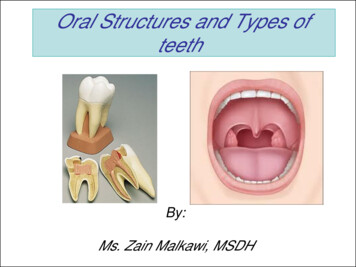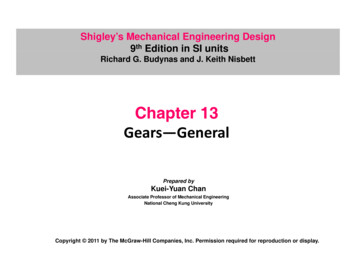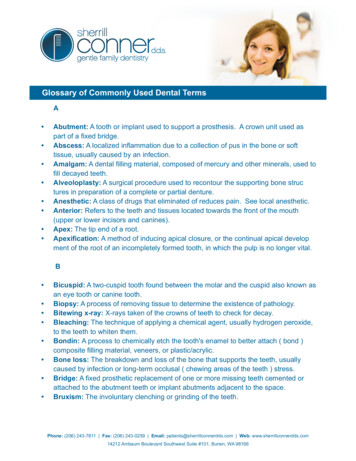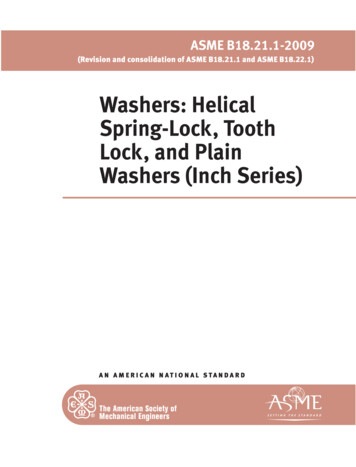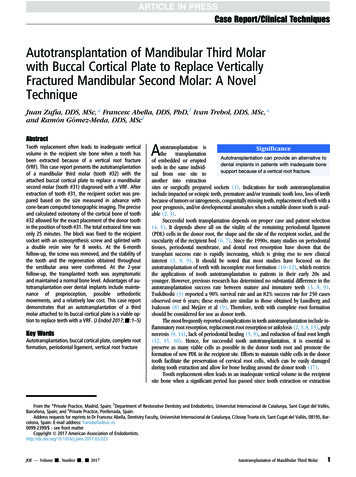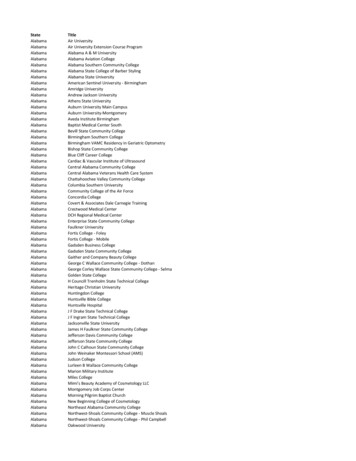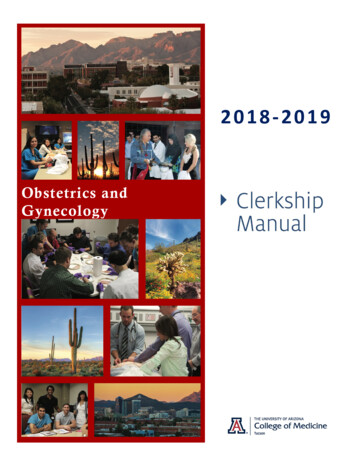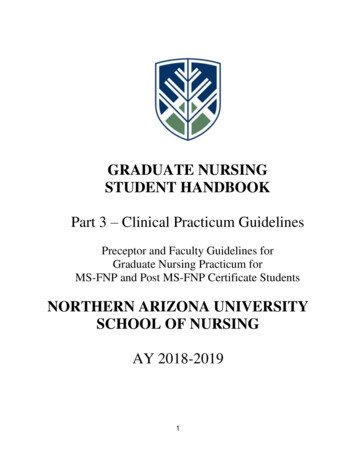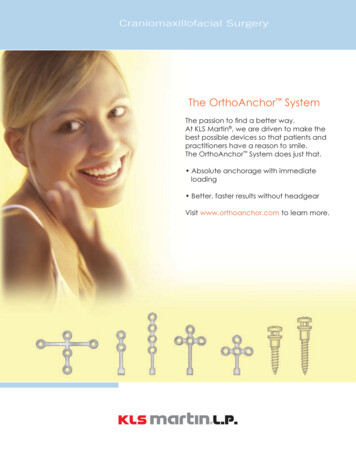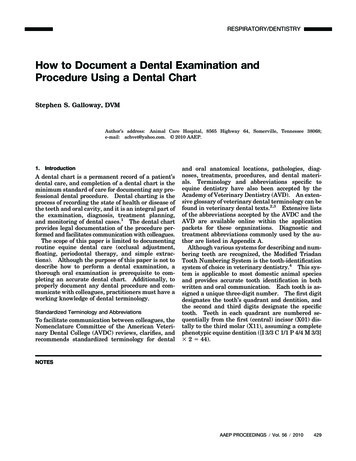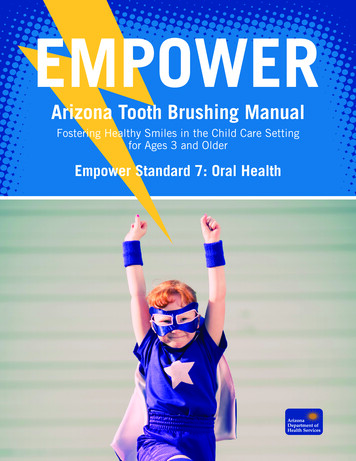
Transcription
Arizona Tooth Brushing ManualFostering Healthy Smiles in the Child Care Settingfor Ages 3 and OlderEmpower Standard 7: Oral Healthi
i
Table of ContentEmpower StandardsPart One: Empower and Oral Health.1Why The Empower Oral Health Standard Is Important. 1The Importance of Healthy “Baby” (Primary) Teeth. 2How Does Tooth Decay Develop. 2What Does Tooth Decay Look Like?. 4Prevention of Tooth Decay. 5Part Two: Tooth Brushing Program Implementation.6Informing Families About Your Tooth Brushing Program. 6Sample Suggestions for Family Involvement. 6Sample Parent Permission Form. 7Organization of the Tooth Brushing Activity and Staff Supervision. 8Recommended Supplies. 8Cleaning Equipment. 8Environment. 8What Time of the Day for Tooth Brushing. 8Where to Brush. 9Selection of Toothpaste. 9Clean, Safe Ways to Dispense Toothpaste. 10Staff Involvement and Supervision. 11Steps for an Effective Tooth Brushing Program. 12Sanitation Concerns: Safe Handling of Toothbrushes and Toothpaste. 15Selection of Toothbrushes. 16Replacing Children’s Toothbrushes. 16Storing Toothbrushes. 16Managing and Storing Supplies. 17Toothbrush Labeling. 17Ordering Toothbrushes. 17Toothbrush Storage Systems. 17Adaptations for Children with Special Health Care Needs or Those withBehavioral Problems. 18Part Three: Additional Resources.19Frequently Asked Questions About Oral Health. 19Reliable Websites Related to Oral Health. 21Websites to Purchase Supplies. 21Healthy Baby Teeth and a Healthy Smile Help a Child Develop Good Self-Esteem!ii
EMPOWER10 Ways to Empower Children to Live Healthy LivesStandard 1: Provide at least 60 minutes of daily physical activity (teacher-led andfree play) and do not allow more than 60 minutes of sedentary activityat a time, or more than three hours of screen time per week.Standard 2: Practice “sun safety.”Standard 3: Provide a breastfeeding-friendly environment.Standard 4: Determine whether site is eligible for the United States Department ofAgriculture (USDA) Child and Adult Care Food Program (CACFP), andparticipate if eligible.Standard 5: Limit serving fruit juice to no more than two times per week.Standard 6: Serve meals family style and do not use food as a reward.Standard 7: Provide monthly oral healthcare education or implement atoothbrushing program.Standard 8: Ensure that staff members receive three hours of training annually onEmpower topics.Standard 9: Make Arizona Smokers’ Helpline (ASHLine) education materialsavailable at all times.Standard 10: Maintain a smoke-free campus.Empower child care facilities will develop and implement a written policy for eachstandard that meets the needs of all children served.Policies should be effective no later than July 1, 2013.Visit us at http://www.theempowerpack.org rev. 11-13iii
STANDARD 7ORAL HEALTHProvide monthly oral healthcare education or implement a tooth brushing program.Part One: Empower and Oral HealthWhy The Empower Oral Health Standard Is Important Tooth decay starts early, progresses quickly, and can be very painful. Thirty-seven (37%) percent of Arizona children ages 2-4 have toothdecay in their baby teeth Tooth decay can cause health problems and can affect learning, speech,and eating. Children at increased risk for tooth decay are those from low-incomefamilies and those with special health care needs (those at risk for or have achronic physical, developmental, behavioral, or emotional condition and alsorequire health and related services of a type or amount beyond that required bychildren generally). Teachers/child care providers are a valuable source of support when it comesto young children’s oral health. Tooth brushing plays an important role in the prevention of tooth decay. Forthis reason, tooth brushing has become an important daily activity in manypreschool and child care settings throughout the nation.The purpose of a tooth brushing program is to promote good oral health practices sothe children in your care can develop an early awareness of the importance of a healthymouth and help promote a lifelong habit of daily tooth brushing.This resource will help teachers/child care providers to: Understand the importance of baby teeth Understand the problem of tooth decay in children Understand the causes of tooth decay and how best to prevent it. Learn strategies to effectively implement a tooth brushing program in achild care setting.For children 2 and under, it is recommended that families brush the child’s teeth twice aday and visit the dentist by one year of age. The dentist can recommend appropriateoral hygiene care and the adequate use of fluoridated toothpaste.1
Tooth Decay is Almost Entirely Preventable!While the Empower Program encourages a tooth brushing program, we realize it may notbe feasible for everyone. However, Standard 7 of the Empower Program gives facilities theoption of implementing a tooth brushing program OR introducing oral health education inthe classroom through teacher-led and age-appropriate activities, while at the same timeeducating parents. Please check out resources for teachers and families at the Empowerwebsite: www.theempowerpack.orgThe Importance of Healthy “Baby” (Primary) TeethBaby Teeth Are Needed For: Chewing food well for good nutrition; Speech development; Development of the jaw bones and muscles of the face; Holding space for and guiding adult teeth into proper position, whichhappens until the child is around 12 years of age; and Good self-esteem.Tooth Decay in Baby Teeth Can Cause: Pain and infection that, in rare cases, can be fatal; An increase in the amount of tooth decay in adult teeth; Failure to thrive; Impaired speech development and absence from and inability to concentratein school; Reduced self-esteem; Decreased school performance; Poor social relationships and less success later in life.How Does Tooth Decay DevelopTooth Decay Is an active process that causes holes or cavities in the teeth resulting frominteractions between TOOTH BACTERIA SUGAR TIME TOOTH DECAY Is an infectious disease, meaning the bacteria (germs) that cause tooth decaycan be transmitted (passed) from person to person.Tooth Decay Bacteria Are not present at birth. Are transmitted (passed) to baby usually by the age of three. Are transmitted from mother or ANYONE who regularly cares for a baby andhas or had TOOTH DECAY.2
Dental Plaque Is a soft, yellow-white, sticky film of bacteria (germs) saliva food residualsfound on teeth and gums that form on teeth every day. Though you may notbe able to see dental plaque, you can feel it as a fuzzy layer on your teeth. Uses sugar from the foods we eat to form acids. If dental plaque is notremoved daily through brushing, the repeated acid attacks cancause tooth decay and irritate the gums. Daily brushing removes the plaque and helps keep teeth and gums healthy.There are several causes of tooth decay among American children. The combinationof bacteria and the frequent consumption of foods such as sugar-coated cereal, cake,cookies, and any sticky sweets contribute to the risk for tooth decay.The following sketch shows the process that teeth follow in developing tooth decay.The Recipe for Tooth Decay FormationTOOTHBACTERIAIN PLAQUESUGARIN FOODTIMETOOTHDECAYA Balanced Healthy Diet is the Building Block of Healthy Teeth in a Healthy Body!Baby teeth have a thinner layer of the outer surface, or enamel, compared to adult teethand that is why tooth decay happens much faster in young children.3
What Does Tooth Decay Look Like?Early Tooth Decay The first indications of tooth decay mayinclude white and chalky spots on theteeth, often near the gum line.At this stage, the tooth decay processcan be stopped if: Minerals like fluoride in drinking waterand toothpaste are used on a regularbasis; and High-carbohydrate foods and sugary drinksare limited in the child’s diet.Moderate Tooth Decay If early tooth decay is not addressedthrough brushing, fluoride exposureand diet changes, it advances toeventually form a hole or cavity in thetooth. Once the tooth has a cavity or“hole,” the child must be treatedby a dentist.Advanced or Severe Tooth DecayIf tooth decay is not treated (indicated bythe dark tooth color), the resulting infectionmay spread to the nerves and blood vesselsof the tooth. The decayed tooth can cause severe painand the infection can spread to otherparts of the body. This severe infection must be treatedimmediately.4
Prevention of Tooth DecayFortunately, tooth decay is almost entirely preventable. In the child care setting, youcan help prevent tooth decay by implementing a tooth brushing program to increasechildren’s awareness of the importance of tooth brushing and to form early good oralhealth habits.Two good reasons why tooth brushing is important:1. Regular daily tooth brushing with appropriate fluoride toothpaste is highlyeffective in preventing tooth decay2. Good oral hygiene practices should be established early in a child’s life andbecome an integral part of normal daily hygiene.While a tooth brushing program is optional, it provides a valuable tool forreinforcing good oral hygiene. Just as children learn the importance of washingtheir hands before eating, they will learn that brushing their teeth after eatingand before going to bed are healthy habits.5
Part Two: Tooth Brushing Program ImplementationThe following program is targeted to children ages 3-5.While this routine is provided as a guide, your facility may need to modify it slightlyto suit your environment.Before starting the programIt will be important for the child care facility to consider all policies and practicesthat either promote or prevent good oral health. It is also recommended that childcare staff be provided with training on how to run the program.Steps to implementing the program:1.2.3.4.5.6.Informing families about the tooth brushing program;Organization of the tooth brushing activity and staff supervision;Sanitation concerns: safe handling of toothbrushes and toothpaste;Tooth brushing instructions;Managing and storing supplies; andAdaptations for children with special health care needs.Informing Families About Your Tooth Brushing ProgramFamilies are a very important part of establishing a tooth brushing program in your facility.In particular, their implementation of home oral care is an essential start for goodoral health habits. They can ensure that children are assisted in brushing their teethusing the correct techniques at home.This manual provides resources and suggested activities to engage and inform familiesfrom the beginning of your tooth brushing program. The first step is to informfamilies and obtain appropriate parental consent. Sample letter and consent forms areincluded below.Families are more likely to become active supporters of the tooth brushing programif they are given a role. There are many opportunities for this in the program – fromdeveloping ideas for ways to incorporate Empower policies into your facility, totaking part in the various oral health activities. Providing families with accessibleinformation about healthy food choices and effective oral hygiene will help them toencourage their children to adopt healthy behaviors.Sample Suggestions for Family Involvement You could have an information night and/or send home information about whytooth brushing is so important in preventing tooth decay. Make sure yourstaff are also well-informed and are equipped to discuss with families. You may want to invite a Registered Dietitian Nutritionist and/or dentalprofessional to talk to staff about oral health and appropriate tooth brushing. Face-to-face reminders and updates help keep families informed and can beeffectively used to communicate about the tooth brushing program.6
Sample Parent Permission FormDear Parent:[name of facility] is introducing a new oral health program to promote strong healthyteeth among children at the facility. As you know, healthy teeth are an important partof a child’s good self-esteem. We want to make sure all of our children can smile withconfidence.As a part of our program, we will be introducing daily tooth brushing. This meanschildren in our care will brush their teeth at least once during the day, probably afterlunch .We hope the combination of tooth brushing in our facility and at home with you willhelp your child establish positive tooth brushing routines.Starting [date], each child will need:[Insert a list of items that suit your facility’s tooth brushing program (e.g. toothbrush, cup,toothpaste).Your child can participate in the program if:1. He/she is 3 years of age or older AND2. He/she attends child care for more than 4 hours in a day OR3. He/she has a meal while in child care.How does this program work? Children will brush their own teeth once a day under supervision of the childcare staff. Children will use toothpaste with fluoride, accepted by the American DentalAssociation, provided by you or the child care facility. This program follows the recommendations set forth by the ArizonaDepartment of Health Services, Empower Program. This program is great! It will help your child learn about good oral health,develop fine motor skills, and prevent tooth decay.Child’s Name:Parent/Caregiver’s Name:Signature:Date:Comments:7
Organization of the Tooth Brushing Activity and Staff SupervisionRecommended Supplies One small soft toothbrush for each child – clearly labeled with the child’sname and date; ADA-accepted fluoride toothpaste; Disposable cups and paper plates and/or wax paper; Toothbrush labels or markers, toothbrush holder and tooth brushing model.Cleaning Equipment Detergent and gloves for cleaning sinks after daily brushing; Paper towels for wiping the sinks after cleaning; Soap for hand washing; Marking pens for labeling each child’s equipment.EnvironmentThere must be: an area to store toothbrushes that allows for sufficient drying; a suitable sink for brushing (not a bubbler trough or drinking fountain).Please follow the Arizona Child Care Rules and Regulations regarding theproper use of sinks for consumption of water.What Time of the Day for Tooth Brushing Brushing at child care should take place once daily, at a time that fits intothe center’s schedule. For consistency, brush at about the same time eachday. Brushing after the midday meal or before sleeping are the best times tobrush. As this is a busy time for staff, tooth brushing should be scheduled tobe efficient for your child care facility.8
Where to Brush Please follow Arizona Child Care Rules and Regulations regarding the properuse of sinks for consumption of water.Selection of ToothpasteIt is important to know if a child has any possible allergies to ingredients oradditives in toothpaste. Generally, a mild mint flavor is advised because usingfruity flavors may encourage children to eat the toothpaste.For products used with children, please follow the Arizona Child Care Rules andRegulations.When choosing a brand of toothpaste, an important thing tolook for is the American Dental Association (ADA) Seal ofAcceptance.9
Clean, Safe Ways to Dispense ToothpasteTo prevent cross-contamination, the toothpaste should NOT be applied directly to thetoothbrush; it can spread germs. Use no more than a small pea-sized amount of fluoride toothpaste for eachchild. ALWAYS keep the fluoride toothpaste out of the children’s reach andadults/staff should always dispense it.If toothpaste is provided by families, the child should have a label on the toothpastetube. If toothpaste from a single tube is shared among children, it should bedispensed onto a clean piece of wax paper, paper cup, or paper plate for each child,rather than directly onto the toothbrush.Wax Paper, Paper Plate or Paper Cup:1. To prevent cross-contamination, you can dispense a pea-sized amount of toothpastefor each child onto a large piece of wax paper, paper plate or inside the lip of a papercup.2. These can then be distributed and children can “scoop” up the toothpaste or anadult can help them “scoop.”Toothpaste Safety!Fluoride toothpaste should always be stored away from children’s reach. Only a child careworker or adult should have access to and handle the fluoride toothpaste.Toothpaste is intended to provide a topical source of fluoride (on the surface); it isNOT supposed to be swallowed by the child. If a child ingests a large amount of fluoridetoothpaste at one time, call the Poison Control Center 1-800-362-0101 for information.10
Staff Involvement and Supervision With children ages 3-5, tooth brushing can best be accomplished as a smallgroup activity, with adults supervising, coaching, and modeling theappropriate technique but not actually brushing the children’s teeth. Children should not be left unattended or be allowed to dispense thetoothpaste. Children must be able to rinse and spit to prevent swallowing of too muchtoothpaste. For children with special health care needs, this activity shouldbe consistent with their individualized plan. In this recommended tooth brushing program, ALL children will bebrushing their own teeth. For this reason, families should be advised thatadditional brushings should take place daily at home, with an adult doingthe brushing for the child at least one time daily until age 7 or 8. Simple modifications and adaptations can be made to help the child withspecial health care needs feel comfortable with group tooth brushing. For children who might have a strong gag reflex or swallow the toothpaste,use half a pea-sized amount of toothpaste or a more mild toothpaste flavor.It can be helpful to designate specific tasks to each staff member. Some tasks mayinclude: Keeping track of purchasing toothbrushes and/or toothpaste; Making and/or purchasing toothbrush labels and storage devices; Organizing children in groups and observing them during brushing; Distributing toothpaste to children over ages 3-5 (get a pea-sized dab), andensuring it is safely stored away from children after use; Coaching children to rinse with water and spit to prevent swallowing; Organizing children to get their brush rinsed thoroughly and into theirappropriate storage space.Also consider Rewards, in the way of positive verbal reinforcement. Child-selected toothbrush colors. Using timers for 2 minutes egg timers or manual timing. Making up or learning several different tooth brushing songs before theactivity (see Empower Guidebook for examples). A chart with stickers to show success in remembering the tooth brushingsteps.11
Steps for an Effective Tooth Brushing ProgramSuggestions for Introducing the Program to Children Prior to Tooth BrushingSet the Atmosphere Approach oral care with a positive attitude and make it fun for the children. Use the ‘tell, show, do’ approach when introducing new items or steps. Model tooth brushing by demonstrating on yourself. This is considered ahighly effective method of teaching this skill. Picture books, videos, and puppets or toys can also be used to demonstrate. Give lots of positive feedback to reinforce good behavior. Keep a log of what works, what doesn’t, and questions.Session 1. Introduce the idea of tooth brushing in class and talk about the reasons todo it. (see activities for Standard 7 in Empower Pack)Session 2. Introduce the rules for the program. Each center will determine whatrules are needed according to their situation. The children should understand not toshare their toothbrush and not to use it for any other purpose (such as brushing theirfriend’s or their stuffed animal’s hair). Other rules may include how the toothbrushes,cups, and toothpaste will be distributed. It is a good idea to practice the distributionroutine without water or toothpaste at least once or twice before implementing theprogram.Session 3. Demonstrate tooth brushing. Do not use toothpaste for this demonstration.The ideal way to demonstrate is in small groups. An adult and a small group ofchildren face a mirror and brush together. The adult is modeling the tooth brushingskill and the children imitate. This is more effective than demonstrating on a puppetor showing pictures. If this is not possible, sit in a circle for the demonstration, butthe key is to have the adult brush so the children can watch and imitate.Session 4. Practice spitting and rinsing with water to ensure they are able to spit andrinse before introducing toothpaste.When children are brushing their teeth, they are also practicing manualdexterity skills and hand-eye coordination.12
Don’t Rush to Brush!Step 1. An adult should supervise tooth brushing at all times.Step 2. Start by washing your hands and asking children to wash their hands andrinse their toothbrushes with tap water. Child care staff places a small pea-size of toothpaste onto each child’s toothbrush using child’s individual toothpaste. If a single tube of toothpaste is used for the classroom, toothpaste isdispensed onto a paper plate, wax paper, or into individual paper cups.Step 3. Children should be encouraged to clean their teeth using the demonstratedtechnique and should brush for approximately two minutes (some groups have foundit useful to play a song during this time). Spit toothpaste out into the sink. Rinse with a little tap water provided in a disposable paper cup.Step 4. When the children are finished brushing, they shall: Dispose of their cup. Cups should not be shared or used again and shouldbe thrown away after one use. Rinse their own toothbrush.Step 5. Toothbrushes are replaced in the toothbrush holder to air dry.Step 6. Be sure to clean the sink area as you would normally; there is no need forspecial clean-up. A solution of detergent and water may be used to wash down thesink where toothpaste has accumulated.13
These instructions will guide children to brush well in 2 minutes.The goal is for children to strive to brushevery tooth, to become aware that eachtooth has a cheek side, a tongue side, andchewing surfaces, and to brush in a pattern,concentrating on each tooth as they go. Spend at least 30 seconds on eachsection of the mouth (top, bottom, left,right), adding up to two minutes for thecomplete tooth brushing time. Start by placing the tip of the bristlesof the toothbrush towards the gumline on the top outside surface of theback teeth and gently “jiggling” it intiny circles along every tooth, makingsure you clean the area where the toothmeets the gums. With this circular motion, slowly moveforward towards the front teeth only asmall group of teeth at a time until theentire arch is covered. On inside surfaces of top front teeth,use small circular motions in gentle upand down strokes, touching everysurface of each tooth with the brush. Continue to jiggle around the front ofthe mouth and cover the back teeth onthe opposite side. Repeat the same brushing method onthe bottom inside and outside surfacesof all teeth. Next, place the toothbrush bristles onthe chewing surfaces, hold the brushflat and use a light backward andforward motion for bottom and topteeth.14
Sanitation Concerns: Safe Handling of Toothbrushes and ToothpasteYoung children drop, share, sit on, and play games with toothbrushes if not carefullysupervised. Toothbrushes can get contaminated with bacteria, saliva, and food afterbrushing. All precautions should be taken to ensure proper storage and handling oftoothbrushes and toothpaste to prevent cross-contamination of germs.Measures for a Sanitary Tooth Brushing Program in a Child Care Setting Ensure that each child has his or her own toothbrush clearly labeled. Do notallow children to share or borrow toothbrushes. Children’s hands should be clean for the brushing activity. Pick up toothbrushes by their handles only, never from the bristles. Ensure that children rinse their toothbrushes thoroughly with water before and after each use.Store the toothbrushes standing in an upright position so they will air dryand not touch other children’s. Do not store toothbrushes in the vicinity offlushing toilets.Children should be supervised to prevent accidental spitting on each other’sarms, hands, and toothbrushes.Do not let the toothbrushes drip onto one another.Do not cover toothbrushes with anything that could prevent them from dryingbetween uses.If a toothbrush has been contaminated or has been used by another child, itshould be thrown away.Make sure that toothbrushes do not become contaminated in the bathroomfrom toileting and handwashing activities.The holding racks should be scrubbed, cleaned, and dried on a regular basiswith detergent and water.Provide children with paper cups to use for rinsing after they finishbrushing. Do not allow them to share cups, and ensure that they dispose ofthe cups properly after a single use.To prevent cross-contamination of the toothpaste tube, ensure that apea-sized drop of fluoride toothpaste is always dispensed onto a piece ofwax paper, paper plate, or individual paper cup before dispensing any ontothe toothbrush.After the tooth brushing activity, the child care provider and children shouldwash their hands thoroughly with soap and water.Be sure to clean the sink area as you would normally; there is no need forspecial clean-up.15
Selection of Toothbrushes The child’s toothbrush head should be small, about 1 inch by 1/2 inch,enough to reach every tooth, especially the back ones, and should have ahandle suitable for firm grasping. The bristles of the brush should be soft, nylon, and rounded at the ends.Only age-appropriate manual toothbrushes should be used. Some childrenmay benefit from adaptive toothbrushes (see page 19). When selecting toothbrushes, it is important to keep in mind how they willbe stored, since some handles can make storage more difficult.Replacing Children’s ToothbrushesThe old toothbrush should be thrown out and a new one supplied when: The toothbrush is 3-4 months old or the bristles become splayed or worn; or A child has been ill with a cold, the flu, or bacterial infection. If there’s a doubt, please throw it out!How Old is That Toothbrush?Three Ways to Remind You:1. You can keep track of how old the toothbrush is by marking it with the date itwas given to the child using a permanent marker.2. On a calendar or spreadsheet, you can write down the date toothbrushes weregiven and then the date when the brushed should be replaced, which is in about3 months.3. Or use an electronic calendar that automatically reminds you when brushes aredue for changing.Storing Toothbrushes After children finish brushing, they should rinse their toothbrushesthoroughly with water. Do not soak toothbrushes in disinfecting solutions ormouthwash. Toothbrushes should be stored in an upright position, in an open area, andallowed to air dry. Keep them away from the children’s reach where they willnot be coughed or sneezed upon and will not drip on activity areas. Do not cover toothbrushes or store them in closed containers. A moistenvironment is more favorable to bacterial growth than the open air. Toothbrush storage systems can be purchased online. Keep tooth brushing supplies and activities away from food preparation areasand the toilet. Prevent toothbrushes from touching each other during handling or storage.16
Managing and Storing SuppliesStaff members should be designated who will be responsible for managing supplyinventory, ordering/purchasing, storage, and distribution. Establish where supplieswill be safely stored and how they will be distributed to children. Inventory ofsupplies will vary, depending on the number of children that attend your child carefacility.If the tooth brushing program relies on each child’s family to provide toothbrushes and/ortoothpaste, the facility may choose to have extra supplies on hand for children who forgetto bring them from home.Toothbrush LabelingEach child should have an age-appropriate toothbrush labeled with his or her fullname and the date the toothbrush was given to the child. This can be done u
This manual provides resources and suggested activities to engage and inform families from the beginning of your tooth brushing program. The first step is to inform families and obtain appropriate parental consent. Sample letter and consent forms are included below. Families are more likely to become active
